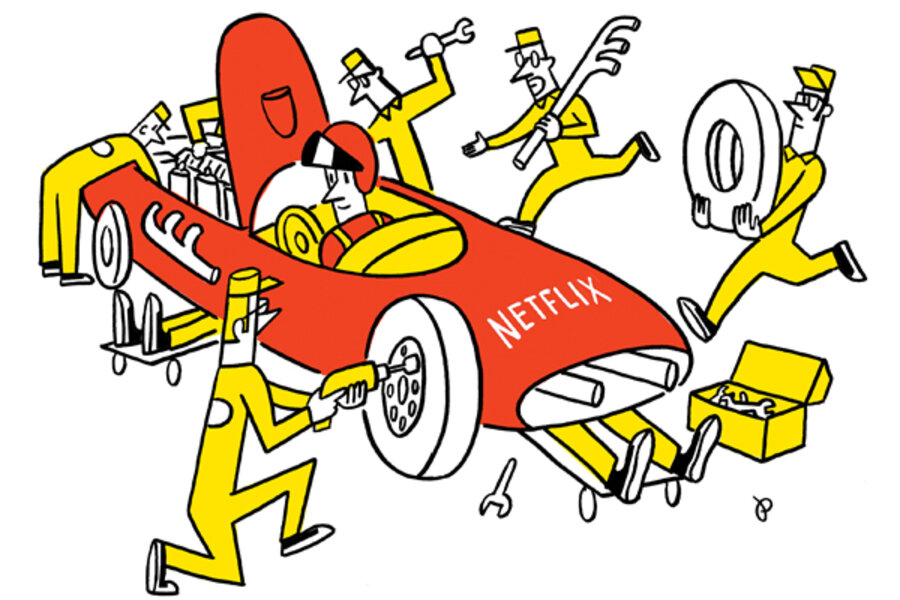Why are Netflix streaming video speeds slowing down?
Loading...
Netflix’s streaming video speeds have slowed significantly over the past six months. The steady decline is not Netflix’s fault, but it is Netflix’s problem. If speeds dip too low, TV shows and movies sent over the online service will stutter, look pixilated, or not play at all.
Netflix chief executive officer Reed Hastings has battled in boardrooms, appealed to the public, and even struck what he considers to be a Faustian bargain in search of a solution. The company’s quest for a cure helps explain how the Internet works behind the scenes, and sheds light on the often murky topic of net neutrality.
From September to March, the average speed at which Netflix video arrived at customers’ homes declined across many of America’s largest Internet providers. People who subscribe to Verizon DSL, for example, saw speeds drop by 42 percent, according to Netflix, whose online “speed index” tracks video download rates for more than 60 US providers.
Why would download speeds drop off by almost half in just six months? With more people streaming video online – whether it is through Netflix, YouTube, Hulu, or any number of other services – the plumbing that services the Internet has become increasingly congested. Now, a battle has broken out over how to address these metaphorical clogged pipes.
Many different companies own the servers, fiber-optic cables, and home connections that make up the Internet. Because of this fragmentation, no single Internet provider can access everything the Web has to offer. They need to work together, or else there would be a Comcast Internet that cannot access the AT&T Internet. To keep things flowing smoothly, big providers often agree to share the load with each other at little or no cost. Essentially, I’ll accept all of your traffic, if you accept mine. But as America’s hunger for streaming video increases, the deals that connected all these different networks have started to fall apart.
Near the end of last year, Netflix made up about a third of all Internet traffic in the United States during prime-time hours – between 9 p.m. and midnight – according to Sandvine, which tracks online traffic. Comcast and Verizon have cried foul. They say the peer relationship that works well between major providers doesn’t make sense with Netflix. Netflix wants to send much more data over Comcast’s wires than what flows the other way. In order to make up for this discrepancy, large providers have demanded that Netflix pay a toll to pass through their networks.
Mr. Hastings has (begrudgingly) agreed. The company cut a deal with Comcast in February and Verizon in late April for more direct access to their networks. Hastings considers this a bad yet necessary short-term solution – a move that, in the end, could hurt the Internet. He worries that broadband providers have been slowing down streaming video on purpose. The month after Netflix signed the deal with Comcast, its average download speed to Comcast subscribers increased by 55 percent. This is ostensibly good news, but it came with the announcement of a price increase for new Netflix customers.
With 36 million subscribers in the US, Netflix can shoulder the cost of paying off Internet providers – as can Microsoft, Google, and Facebook, which have signed similar deals to ensure that their data reach users in a smooth and timely manner. But this sets a bad precedent, according to Hastings and proponents of net neutrality, who say that providers should not discriminate between different kinds of data.
“The next Facebook, the next YouTube, future breakthroughs in medicine and education, they might not be able to afford these tolls,” says Mitch Stoltz, staff attorney for the Electronic Frontier Foundation.
The Federal Communications Commission plans to hash out its new Internet doctrine this month. Early drafts would codify the idea that broadband providers can charge companies for faster service. More than 100 technology firms including Google, Facebook, Amazon, and Netflix signed an open letter urging the FCC to uphold net neutrality. Doing otherwise, they say, “represents a grave threat to the Internet.”
For more on how technology intersects daily life, follow Chris on Twitter @venturenaut.
This article appeared in the May 26 issue of The Christian Science Monitor magazine.





